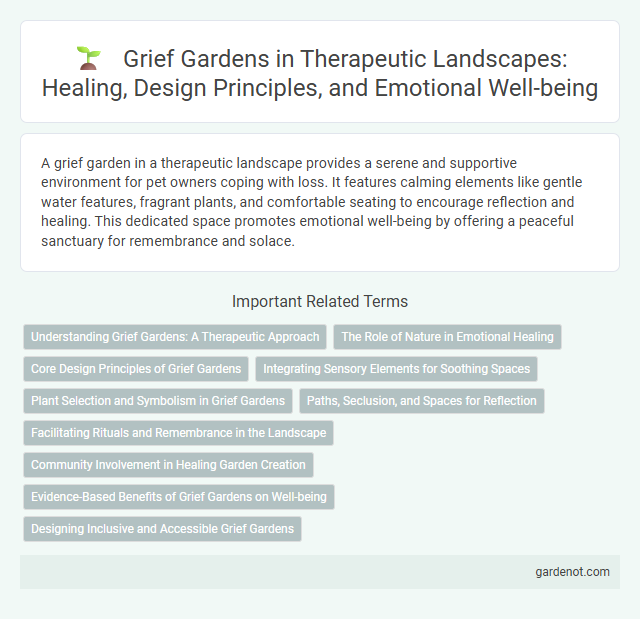A grief garden in a therapeutic landscape provides a serene and supportive environment for pet owners coping with loss. It features calming elements like gentle water features, fragrant plants, and comfortable seating to encourage reflection and healing. This dedicated space promotes emotional well-being by offering a peaceful sanctuary for remembrance and solace.
Understanding Grief Gardens: A Therapeutic Approach
Grief gardens provide a therapeutic landscape designed to support emotional healing by offering a peaceful, reflective environment where individuals can process loss and sorrow. These gardens incorporate sensory elements such as soothing plants, water features, and memorial spaces that facilitate mindfulness and comfort during bereavement. Research shows that interaction with natural surroundings in grief gardens reduces stress hormones and promotes psychological resilience in those coping with grief.
The Role of Nature in Emotional Healing
Grief gardens harness the therapeutic power of nature by providing serene environments that facilitate emotional healing and reflection. Natural elements like plants, water features, and open green spaces stimulate sensory engagement, reducing stress and promoting mental restoration. Research shows that spending time in these curated natural settings significantly lowers cortisol levels and enhances emotional resilience during grief recovery.
Core Design Principles of Grief Gardens
Grief gardens are designed around core principles that promote emotional healing, such as incorporating natural elements like water features and native plants to foster tranquility and reflection. Spatial arrangements prioritize privacy and quiet areas to allow individuals to process grief in a safe, contemplative environment. The use of symbolic features, comfortable seating, and accessible pathways ensures inclusivity and supports diverse needs during the mourning process.
Integrating Sensory Elements for Soothing Spaces
Grief gardens integrate sensory elements such as fragrant flowers, textured plants, and gentle water features to create soothing spaces that promote emotional healing. Incorporating natural sounds, tactile materials, and calming scents enhances mindfulness and reduces anxiety for visitors experiencing loss. These sensory-rich environments support therapeutic benefits by engaging multiple senses, fostering reflection, and offering comfort in times of grief.
Plant Selection and Symbolism in Grief Gardens
Plant selection in grief gardens emphasizes species with symbolic meanings such as white lilies for purity, forget-me-nots for remembrance, and evergreens for eternal life. Incorporating plants that bloom in different seasons ensures year-round comfort and reflection for visitors. These carefully chosen plants foster emotional healing by connecting mourners with nature's cycles of renewal and hope.
Paths, Seclusion, and Spaces for Reflection
Grief gardens are designed with winding paths that encourage slow, mindful walks, promoting healing through gentle movement and contemplation. Secluded areas within these gardens provide privacy, allowing individuals to process emotions in a safe, undisturbed environment. Expansive spaces for reflection offer benches and natural elements that foster introspection, supporting emotional recovery and mental well-being.
Facilitating Rituals and Remembrance in the Landscape
Grief gardens provide dedicated spaces that facilitate rituals and remembrance, allowing individuals to process loss through meaningful ceremonies and personal reflection. Elements such as memory walls, engraved stones, and contemplative seating support ritualistic practices, fostering emotional healing and connection within the therapeutic landscape. These gardens enhance grief management by offering a serene environment for memorial activities and communal grieving.
Community Involvement in Healing Garden Creation
Community involvement in grief garden creation fosters collective healing by integrating diverse cultural rituals and shared memories into the landscape design. Active participation from local groups enhances emotional support networks, creating a therapeutic environment that reflects communal values and stories. Collaborative efforts in planting and maintaining the garden strengthen social bonds, promoting resilience and long-term well-being among participants.
Evidence-Based Benefits of Grief Gardens on Well-being
Grief gardens provide evidence-based benefits by offering restorative environments that reduce stress and promote emotional healing, supported by studies linking nature exposure to decreased cortisol levels and improved mood. These therapeutic landscapes facilitate reflective practices, fostering resilience and enhancing mental well-being in individuals experiencing bereavement. Incorporating elements such as fragrant plants, seating areas, and calming water features, grief gardens serve as scientifically validated spaces that aid in processing loss and nurturing psychological recovery.
Designing Inclusive and Accessible Grief Gardens
Designing inclusive and accessible grief gardens involves creating therapeutic landscapes that accommodate diverse physical abilities and cultural backgrounds to foster healing and reflection. Incorporating universal design principles, such as smooth pathways, sensory plantings, and adaptable seating, ensures all visitors can engage meaningfully with the space. Prioritizing accessibility enhances emotional support by providing a welcoming environment for individuals experiencing loss, promoting solace and community connection.
Grief garden Infographic

 gardenot.com
gardenot.com